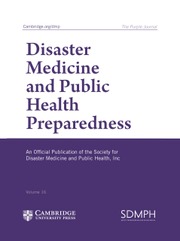Article contents
Extreme Measures: Field Amputation on the Living and Dismemberment of the Deceased to Extricate Individuals Entrapped in Collapsed Structures
Published online by Cambridge University Press: 08 April 2013
Abstract
Collapsed structures, typically as a result of earthquakes, may result in individuals entrapped by their limbs under heavy structural elements. In addition, access to living persons may be blocked by the deceased. Individuals are often critically ill by the time they are found, and rapid extrication is warranted. This and other factors may necessitate field amputation of an extremity on a living person or dismemberment of the deceased to achieve a rescue. Although case reports have described industrial, mining, and transportation accidents, few discuss this potential in collapsed structures. Also, few specifically outline the indications or the decision process and associated administrative procedures that should be addressed before conducting these procedures. This report presents a review of the literature along with a limited case series. A discussion regarding relevant decision making is provided to encourage the development of protocols. An international consensus statement on these procedures is provided.
(Disaster Med Public Health Preparedness. 2012;6:428-435)
Keywords
- Type
- Special Focus
- Information
- Disaster Medicine and Public Health Preparedness , Volume 6 , Issue 4 , December 2012 , pp. 428 - 435
- Copyright
- Copyright © Society for Disaster Medicine and Public Health, Inc. 2012
References
REFERENCES
- 8
- Cited by


